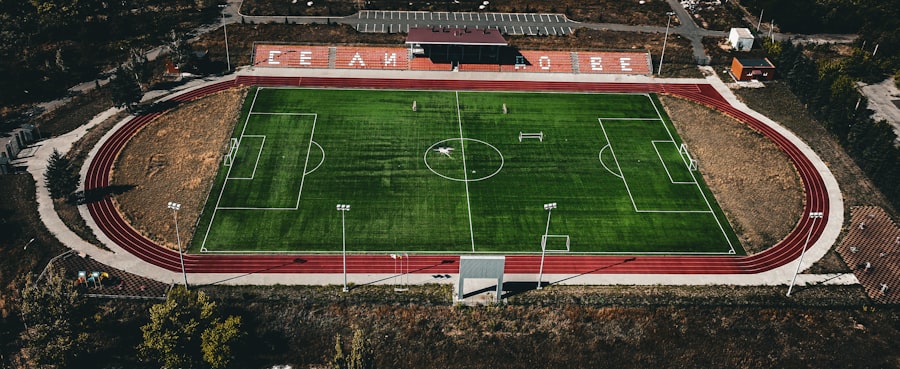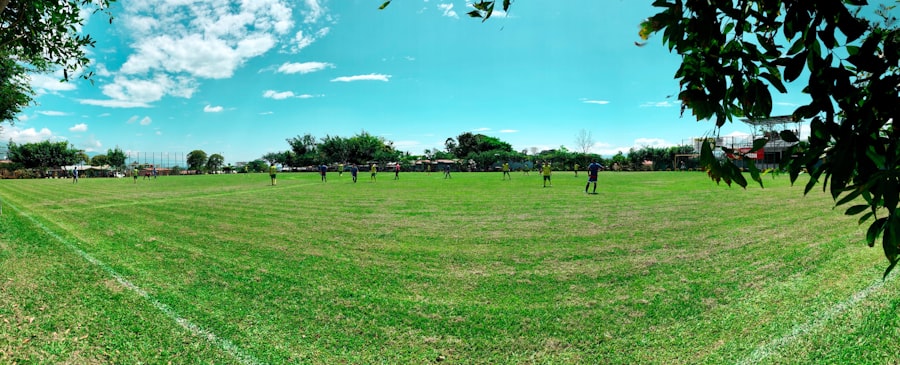The history of Portobello’s football pitches is deeply intertwined with the evolution of the community itself. Initially, the area was characterized by its rugged landscape and a strong maritime culture, which shaped the recreational activities available to its residents. In the late 19th century, as urbanization began to take hold, the need for organized sports became apparent.
The establishment of the first football pitches in Portobello can be traced back to this period, when local clubs began to form, driven by a burgeoning interest in the sport. These early pitches were often rudimentary, marked out on open fields or repurposed land, reflecting the community’s grassroots approach to recreation. As the 20th century progressed, Portobello’s football pitches underwent significant transformations.
The post-war era saw an increase in leisure time and a growing emphasis on physical fitness, leading to a surge in participation in football. Local authorities recognized the importance of these spaces not only for sport but also for community cohesion. By the 1960s and 1970s, more formalized pitches were developed, complete with basic amenities such as changing rooms and spectator areas.
This evolution mirrored broader societal changes, as football became a central part of local identity and pride, fostering a sense of belonging among residents.
Key Takeaways
- Portobello’s football pitches have evolved significantly, reflecting changes in urban recreation over time.
- The redevelopment has positively impacted the local community by promoting social interaction and physical activity.
- Modern design and technology enhancements improve user experience and accessibility on the pitches.
- Inclusivity is a key focus, ensuring the facilities cater to diverse groups and abilities.
- The project demonstrates economic and social benefits, offering valuable insights for future urban recreation initiatives.
The Transformation of Urban Recreation
Urban recreation has undergone a profound transformation over the past few decades, with Portobello serving as a microcosm of these changes. Historically, recreational spaces were often neglected or underutilized, primarily serving as informal gathering spots rather than structured environments for organized sports. However, the shift towards valuing health and wellness has led to a reimagining of these spaces.
In Portobello, this transformation is evident in the revitalization of football pitches that now cater to a diverse range of activities beyond just football. The introduction of multi-use facilities has been a key aspect of this transformation. In addition to traditional football matches, these pitches now host community events, fitness classes, and youth programs.
This diversification not only maximizes the use of space but also encourages broader community engagement. The integration of green spaces and recreational areas around the pitches has further enhanced their appeal, creating environments where families can gather and socialize while enjoying various activities. This holistic approach to urban recreation reflects a growing recognition of the importance of physical activity in promoting mental well-being and social interaction.
The Impact on the Local Community

The impact of Portobello’s football pitches on the local community is multifaceted, influencing social dynamics, health outcomes, and community identity. One of the most significant effects has been the fostering of social cohesion among residents. Football has long been a unifying force, bringing together individuals from diverse backgrounds and age groups.
The pitches serve as a communal hub where friendships are forged, rivalries are born, and local pride is cultivated. This sense of belonging is particularly important in urban settings where individuals may feel isolated amidst the hustle and bustle of city life. Moreover, the health benefits associated with increased physical activity cannot be overstated.
With rising concerns about sedentary lifestyles and related health issues, the availability of well-maintained football pitches encourages residents to engage in regular exercise. Local initiatives promoting youth participation in sports have also emerged, targeting schools and community organizations to ensure that children have access to these facilities. As a result, there has been a noticeable increase in youth engagement in sports, contributing to healthier lifestyles and improved physical fitness among younger generations.
The Design and Features of the Pitches
| Pitch Feature | Description | Standard Dimensions | Surface Type | Additional Features |
|---|---|---|---|---|
| Length | The total length of the pitch from end to end | 100-110 meters | Grass, Artificial Turf | Drainage system for water runoff |
| Width | The total width of the pitch from side to side | 64-75 meters | Natural or Synthetic | Perimeter fencing for safety |
| Goal Area | Area in front of the goal where goal kicks are taken | 5.5 meters from each goal post and 5.5 meters into the pitch | Same as pitch surface | Marked with white lines |
| Penalty Area | Area where fouls result in penalty kicks | 16.5 meters from each goal post and 16.5 meters into the pitch | Same as pitch surface | Includes penalty spot and arc |
| Center Circle | Circle at the center of the pitch for kick-offs | Radius of 9.15 meters | Same as pitch surface | Marked with white paint |
| Surface Quality | Type and maintenance of the playing surface | N/A | Natural grass or FIFA-approved artificial turf | Regular mowing, watering, and aeration |
| Lighting | Illumination for evening or night matches | Minimum 500 lux for amateur, 1200 lux for professional | N/A | Evenly distributed floodlights |
The design and features of Portobello’s football pitches reflect a thoughtful approach to creating functional and inviting spaces for recreation. Modern pitches are equipped with high-quality playing surfaces that meet regulatory standards for safety and performance. The use of artificial turf has become increasingly popular due to its durability and low maintenance requirements, allowing for year-round play regardless of weather conditions.
This innovation ensures that the pitches remain accessible to players at all times, reducing cancellations due to poor field conditions. In addition to the playing surfaces, the design incorporates essential amenities that enhance the overall experience for users. Changing rooms equipped with showers provide convenience for players before and after matches, while spectator areas offer comfortable seating for families and friends who come to support their teams.
Furthermore, thoughtful landscaping around the pitches creates an inviting atmosphere that encourages community members to spend time in these spaces even when not actively participating in sports. Features such as walking paths, picnic areas, and playgrounds contribute to a vibrant recreational environment that caters to all ages.
The Role of Technology in Enhancing the Experience
Technology plays an increasingly vital role in enhancing the experience of using Portobello’s football pitches. From smart lighting systems that adjust based on usage patterns to digital booking platforms that streamline access to facilities, technological advancements have transformed how residents interact with these spaces. For instance, many pitches now feature LED lighting that not only improves visibility during evening games but also reduces energy consumption compared to traditional lighting systems.
Moreover, technology has facilitated better communication between local authorities and community members regarding pitch availability and maintenance schedules. Mobile applications allow users to check real-time updates on pitch conditions or reserve slots for games, making it easier for teams to organize matches without unnecessary delays or confusion. Additionally, data analytics can be employed to monitor usage patterns and inform future improvements or expansions based on community needs.
This integration of technology not only enhances user experience but also promotes efficient management of public resources.
The Importance of Inclusivity and Accessibility

Inclusivity and accessibility are paramount considerations in the development and management of Portobello’s football pitches. Recognizing that sports should be available to everyone regardless of ability or background has led to initiatives aimed at making these facilities welcoming for all members of the community. This includes designing pitches that accommodate individuals with disabilities by incorporating features such as wheelchair-accessible pathways and adaptive sports programs.
Community outreach efforts have also been instrumental in promoting inclusivity within local sports culture. Programs targeting underrepresented groups—such as women, ethnic minorities, and individuals with disabilities—have been established to encourage participation in football and other recreational activities. By fostering an environment where everyone feels valued and included, Portobello’s football pitches serve as a model for how urban recreational spaces can contribute to social equity and cohesion.
The Future of Urban Recreation: Lessons from Portobello
The evolution of urban recreation in Portobello offers valuable lessons for other communities seeking to enhance their recreational offerings. One key takeaway is the importance of community involvement in the planning and development process. Engaging residents in discussions about their needs and preferences ensures that facilities are tailored to serve their interests effectively.
This participatory approach not only fosters a sense of ownership among community members but also leads to more sustainable outcomes. Additionally, the integration of diverse recreational activities beyond traditional sports is crucial for maximizing the utility of urban spaces. By creating multi-functional facilities that cater to various interests—such as fitness classes, cultural events, or family gatherings—communities can foster greater engagement among residents.
Portobello’s experience demonstrates that successful urban recreation is not solely about providing sports facilities; it is about creating vibrant spaces that promote social interaction and well-being across all demographics.
The Economic and Social Benefits of the Project
The economic and social benefits stemming from Portobello’s investment in football pitches extend far beyond mere recreational opportunities. From an economic perspective, enhanced recreational facilities can attract visitors from neighboring areas who come to participate in tournaments or events hosted at these pitches. This influx can stimulate local businesses such as cafes, shops, and service providers who cater to both players and spectators alike.
Socially, the project has contributed significantly to community development by fostering pride in local identity through sports achievements and events held at these venues. The sense of belonging cultivated through shared experiences on the pitch translates into stronger community ties and increased civic engagement. Furthermore, initiatives aimed at promoting youth participation not only address health concerns but also provide pathways for personal development through teamwork and leadership skills learned on the field.
Overall, Portobello’s football pitches exemplify how thoughtful investment in urban recreation can yield substantial returns for both individuals and communities alike.



